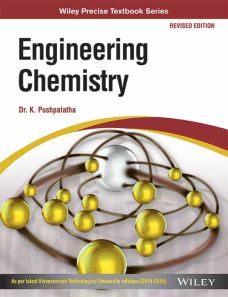Engineering Chemistry, Revised ed, (As per 2014 - 15 syllabus of VTU)
ISBN: 9788126551842
392 pages
Publication Year: 2014
For more information write to us at: acadmktg@wiley.com

Description
The Engineering Chemistry course for undergraduate students is designed to strengthen the fundamentals of chemistry and then build an interface of theoretical concepts with their industrial/engineering applications. This book is structured keeping in view the objective of the course and is exclusively designed for the first-year engineering undergraduate students of Visvesvaraya Technological University (VTU). The book aims to impart to students an in-depth knowledge of various aspects of chemistry as applied to engineering. It deals with advanced topics relevant to Engineering Chemistry course, that include Electrode Potential and Cells, Batteries and Fuel Cells, Corrosion and its Control, Metal Finishing, Chemical Fuels and Photovoltaic Cells, Water and its Treatment and Instrumental Methods of Analyses.
Preface
1. Electrode Potential and Cells
1.1 Electrochemical Cells
1.2 Electrode Potential
1.3 Galvanic Cells
1.4 Nernst Equation
1.5 Measurement of EMF of the Cell
1.6 Types of Electrodes
1.7 Reference Electrodes
1.8 Single Electrode Potential
1.9 Glass Electrode
1.10 Concentration Cells
2. Batteries and Fuel Cells
2.1 Classification of Batteries
2.2 Characteristics of a Battery
2.3 Classical Batteries
2.4 Modern Batteries
2.5 Fuel Cells
2.6 Types of Fuel Cells
2.7 Supercapacitor
3. Corrosion and Its Control
3.1 Corrosion in Metals and Alloys
3.2 Corrosion Cell
3.3 Types of Corrosion
3.4 Types of Electrochemical Corrosion
3.5 Other Types of Corrosion
3.6 Factors Influencing Rate of Corrosion
3.7 Corrosion Control Methods
3.8 Protective Coatings
4. Metal Finishing
4.1 Essentials of Metal Finishing
4.2 Electroplating Process
4.3 Effect of Plating Variables on Nature of Electrodeposit
4.4 Surface Preparation
4.5 Electroplating of Chromium, Silver, Nickel and Copper
4.6 Electroless Plating
5. Chemical Fuels and Photovoltaic Cells
5.1 Classifications of Fuels
5.2 Calorific Value
5.3 Determination of Calorific Value
5.4 Combustion
5.5 Liquid Fuels - Petroleum
5.6 Power Alcohol and Synthetic Petrol
5.7 Biofuels
5.8 Non-Conventional Energy Resources
5.9 Solar Energy
5.10 Silicon
6. Phase Rule
6.1 Definition of Terms
6.2 Phase Rule
6.3 Phase Diagram
6.4 One-Component Systems
6.5 Two-Component Systems
7. Polymers
7.1 Some Important Terms and Definitions
7.2 Classification of Polymers
7.3 Types of Polymerization
7.4 Mechanism of Addition Polymerization
7.5 Polymerization Techniques
7.6 Molecular Weights of Polymers
7.7 Structure-Property Relationship of Polymers
7.8 Plastics
7.9 Some Important Commercial Thermoplastics
7.10 Some Important Commercial Thermosetting Resins
7.11 Elastomers (Rubbers)
7.12 Some Important Synthetic Rubbers
7.13 Fibers
7.14 Some Important Synthetic and Semisynthetic Fibers
7.15 Composites
7.16 Adhesives
7.17 Conducting polymers
8. Water and Its Treatment
8.1 Sources of Water
8.2 Impurities in Water
8.3 Hardness of Water
8.4 Determination of Hardness of Water
8.5 Alkalinity of Water
8.6 Analysis of Water
8.7 Disadvantages of Hard Water
8.8 Potable Water
8.9 Boiler Feed Water
8.10 Techniques for Water Softening
8.11 Sewage
9. Instrumental Methods of Analysis
9.1 Electro analytical Methods
9.2 Electromagnetic Radiation
9.3 Molecular Spectroscopy
9.4 Basic Spectroscopy Instrumentation
9.5 Flame Photometry
9.6 Chromatography
10. Nanomaterials
10.1 Overview of Nanomaterials
10.2 Properties of Nanomaterials
10.3 General Methods of Synthesis
10.4 Materials Self-Assembly
10.5 Characterization of Nanomaterials
10.6 Nanoscale Materials
10.7 General Applications of Nanomaterials
10.8 Future Perspectives of Nanochemistry
Key Terms
Objective-Type Questions
Review Questions
Answers

